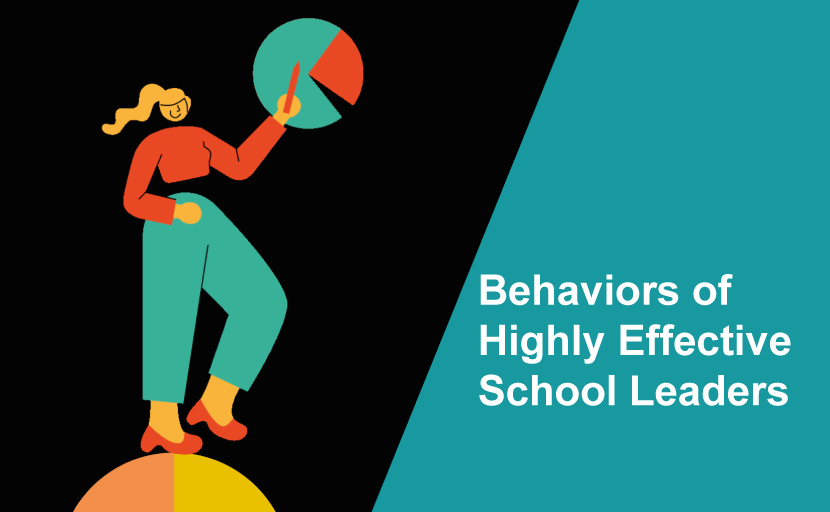The crucial role of school leaders in student learning and achievement is clear, yet the impact of exceptional leaders is often undervalued. New research by the Wallace Foundation suggests that the magnitude and scope of a school leader’s impact may not have been stated strongly enough in previous research and collective understanding. This comprehensive research report identifies four behaviors that effective principals consistently practice to be indispensable to their schools:
- Engaging with teachers on instruction
- Building a productive school climate
- Fostering collaboration
- Managing resources strategically
Before discussing the specific behaviors and what they look like on a daily basis, it’s important we note the three overlapping areas of expertise that emerged from the research: people skills including the ability to build strong relationships and communicate effectively, organizational skills like strategic thinking and extracting insights from data, and instructional skills. These areas of expertise are prerequisites for school leaders to be successful because the skills combine, support, and manifest as the four leadership behaviors that create exceptional school and student outcomes.
Importance of Modeling Behaviors for School Leaders
Modeling the right behavior as a school leader is imperative. It serves as a blueprint for your staff, students, and even parents, showing them the standards and expectations you’ve set. By modeling effective behaviors, you demonstrate that these aren’t just abstract concepts but achievable actions that can be integrated into day-to-day activities.
It also builds credibility, showing that you practice what you preach, which in turn can lead to a culture of mutual respect and a sense of unity within your school community. Furthermore, modeling these behaviors helps in fostering a positive learning environment, where everyone is invested in continuous improvement. By demonstrating exemplary behavior, school leaders inspire and empower others, ultimately driving positive change.
4 Behaviors of Highly Effective School Leaders
As we delve into these leadership traits, it’s imperative to remember the profound influence they have on the school environment. These are not isolated behaviors, but rather interconnected actions that collectively enhance the teaching and learning experiences within your school. So, let’s explore these four key behaviors that shape highly effective school leaders.
1. Engaging with teachers about instruction
Teachers are our most important assets. They interact directly with students every day, and in turn, have an unmistakable impact on student learning. This is why authentic and meaningful teacher support systems are the key to transforming instruction and improving student outcomes. But how do we go about providing support to teachers that is authentic, meaningful, and actually helpful?

Classroom visits, coaching, and school-wide instructional programs are some examples of high-leverage practices school leaders can adopt to create authentic, instruction-focused engagement with teachers.
Habits stick through repetition, and one way to make this leadership behavior a habit is to communicate directly and frequently with teachers about what’s happening in classrooms. Simply making a conscious effort to positively interact with each teacher about their lessons on a daily/weekly basis can make a world of difference.
You can also make an effort to follow up classroom visits with specific feedback in a timely manner, rather than waiting to provide feedback at a routine coaching session or when it’s most convenient to you.
2. Building a productive school climate
While instructional leadership is important, building trust and relationships is foundational. Students learn best when they feel safe, accepted, challenged, and supported. It’s no surprise that teachers perform best in the same conditions. That’s why a positive and productive school environment built on trust, teamwork, efficacy, and continuous improvement must come before a high-functioning instructional program.

If you’re already interacting with your teachers often and providing timely and supportive feedback, you are well on your way to a positive school climate. Other actions you can take on a day-to-day basis are to include teachers in planning and decision-making, participate in professional development and data reflection discussions, and solicit feedback and input.
Most importantly, don’t forget that your words and actions are powerful. In fact, they set the tone for the entire school culture. Are you modeling the behaviors you expect from the team you lead? Every interaction you have with your students, staff and your community at large is reflected in your culture. Make these interactions inspiring, supportive, and geared towards academic excellence.
3. Creating the structure for focused collaboration
Effective school leaders create the structure to support focused, effective, and authentic collaboration among teachers so that, together, they believe that they can improve their practice and have a positive impact on student learning. This notion is at the very heart of collective teacher efficacy.
When collaboration is structured through a systematic protocol and is focused on improving instruction, collaborative meetings encourage professional responsibility, foster positive relationships, and become a powerful vehicle for collective teacher efficacy.

As a school leader, you can support collaboration by earmarking time for it, creating clarity through norms or rules of engagement, and setting expectations to promote accountability. While your presence in collaborative meetings and data discussions can be beneficial and supportive, you need to know when it’s time to take a step back.
It’s important that your teacher team has a sense of autonomy and ownership over collaborative time so they can freely support each other and share best teaching practices.
4. Managing personnel & resources strategically
The positive impact school leaders have on student achievement is indirect, yet powerful, as it’s experienced across the school. This impact is realized through teachers, which underscores the importance of providing support in the form of resources needed for both student and personal learning. Essentially, you will retain your teachers and motivate them to perform when they have the resources they need to carry out the job. There’s nothing less motivating than feeling overworked and under-resourced.
FAQs about Highly Effective School Leaders
Final Words about School Leaders Behaviors
Given the magnitude of impact that school leaders have on student learning, the study suggests that investing in instructional leadership will undoubtedly pay off in a big way. One approach is to make sure your instructional support system facilitates and encourages these leadership behaviors daily, even when there are other demands on your time. When we remove the obstacles to providing quality support to teachers, students ultimately win.
We’re always happy to help and provide input where we can. If you have questions about your instructional support system, we’d love to talk to you. Schedule a complimentary strategy session with a Bullseye expert!


